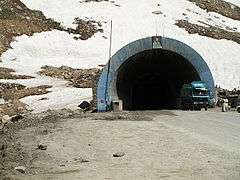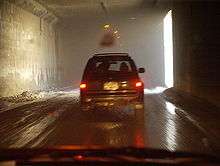Salang Tunnel
Coordinates: 35°19′19.91″N 69°1′36.72″E / 35.3221972°N 69.0268667°E
.jpg)


The Salang Tunnel (Persian: تونل سالنگ Tūnel-e Sālang) is a 2.6 kilometres (1.6 mi) long tunnel located at the Salang Pass in the Hindu Kush mountains, between the Parwan and Baghlan provinces of Afghanistan. It was completed by the Soviet Union in the 1960s and has been used to connect the northern Afghan cities with the capital of Kabul. The tunnel is currently being repaired and improved.[1] Between seven and ten thousand vehicles pass through the tunnel each day.
The Salang Tunnel is the only pass going in a north-south direction to remain in use throughout the year.[2] It is known for a deadly fire which occurred in November 1982, and several avalanche incidents. A series of avalanches led to the deaths of as many as 172 people in February 2010 either as a direct result of the avalanche or through being trapped.
Overview
The tunnel represents the major north-south connection in Afghanistan, cutting travel from 72 hours to 10 hours and saving about 300 kilometres (190 mi). It reaches an altitude of about 3,400 metres (11,200 ft) and is 2.6 kilometres (1.6 mi) long. The width and height of the tunnel tube are 7 metres (23 ft). Other sources say that the tunnel is no more than 20 feet (6.1 m) wide at the base and 16 feet (4.9 m) high, but only in the center.[3]
In 1955, Afghanistan and the former Soviet Union signed an agreement to initiate joint development of the Salang road, initially via the historic Salang Pass route. The tunnel was opened in 1964 and provided a year-round connection from the northern parts of the country to Kabul. The tunnel was the highest road tunnel in the world until 1973, when the United States built the Eisenhower Memorial Tunnel — just slightly higher and slightly longer — in Colorado in the Rocky Mountains.
In 2010, it was noted that about 16,000 vehicles pass the Salang tunnel daily.[4] Other reports say that the tunnel was designed for 1,000 vehicles a day, but is now handling seven to ten thousand vehicles a day.[3]
New tunnel
Technical studies for a second Salang tunnel started in May 2012. USAID has started studying plans to construct the second tunnel in Salang and the cost of the project was expected to be specified after the study has been completed. USAID and the World Bank have shown an interest in helping pay the costs of the project. The new tunnel will decrease the problems of travelling on the Salang highway, on which seven thousand vehicles travel daily. Hence less risk of snow avalanches, and a less winding road in the new tunnel. The new tunnel will stretch further than the current tunnel, but the new road will be 30-40 kilometres shorter when comparing equal distances. The new tunnel will reach from the Olang region in Parwan province to DoShakh in Baghlan province, going through the mountains of the Hindu Kush.[5]
Accidents
1982 fire

During the Soviet-Afghan war, the tunnel was a crucial military link to the South yet prone to ambushes by the mujaheddin. On November 3, 1982 the Salang tunnel fire killed 64 Soviet soldiers and 112 Afghans; apparently after a collision, a tanker truck blew up in the tunnel and the fire engulfed a military convoy. Other sources offer some variation in the number of fatalities; although the Guinness Book of World Records 2007 cites the same figure of "about 176".
After the 1989 Soviet withdrawal from Afghanistan, maintenance suffered, and eventually, in the course of combat between the Afghan Northern Alliance and the Taliban in 1997–1998, the tunnel's entrances, lighting and ventilation system were destroyed, so that it could only be transited by foot in the dark. After the overthrow of the Taliban led government, a joint effort between agencies from Afghanistan, France, Russia, the United States and others cleared the mines and debris and reopened the tunnel on January 19, 2002.[2]
2002 avalanche
Several weeks after reopening several hundred people were trapped in the tunnel due to an avalanche at its southern end. While most people were rescued, fatalities occurred due to asphyxiation and freezing. After further rehabilitation, in July 2004, the tunnel could carry two-way traffic.
2009 avalanches
Avalanches in the approach to the tunnel killed at least ten people in January 2009.[6]
2010 avalanches
On February 8, 2010, a series of at least seventeen avalanches struck the area around the tunnel, burying miles of road, killing dozens of people and stranding hundreds more.[7][8][9][10] Hundreds of cars were buried in the snow.[8] More than 150 people are expected to have been killed in total, according to officials.[7] At least 400 injuries were reported.[11]
The Afghan National Army and NATO used their helicopters to rescue at least 2,500 people who were trapped inside their vehicles.[8]
The avalanches were caused by a sudden blizzard that struck the area, closing the tunnel and the roads around it on both side of the tunnel.[7]
The tunnel was reopened on February 12, 2010.
References
| Wikimedia Commons has media related to Salang Tunnel. |
- ↑ http://www.khaama.com/isaf-finance-salang-tunnels-renovation-1452
- 1 2 Jerome Starkey (9 February 2010). "Avalanches kill 28 and injure dozens near Salang tunnel". The Times. Retrieved 9 February 2010.
- 1 2 U.S.-Pakistan dispute chokes Afghan supply route Retrieve 4 June 2012.
- ↑ IRINnews (February 15, 2010). "Lessons from the Salang pass desaster". Retrieved March 7, 2010.
- ↑ http://www.tolonews.com/en/afghanistan/6031-technical-studies-for-new-salang-tunnel-underway
- ↑ "Afghanistan avalanches kill 10". The Belfast Telegraph. 2009-01-18. Retrieved 2009-01-18.
- 1 2 3 "Afghanistan tunnel avalanches kill 24 in Hindu Kush". BBC. 9 February 2010. Retrieved 9 February 2010.
- 1 2 3 Rod Norland (2010-02-09). "Avalanches Kill Dozens on Mountain Highway in Afghanistan". New York Times. Retrieved 2010-02-10.
Heavy winds and rain set off 17 avalanches that buried more than two miles of highway at a high-altitude pass in the Hindu Kush mountain range, entombing hundreds of cars and cutting off Kabul’s heavily traveled link to northern Afghanistan, officials said Tuesday.
- ↑ Rahim Faiez (2010-02-09). "Avalanches swamp Afghan pass: Scores of bodies pulled from cars as coalition joins search for injured". Toronto Star. Retrieved 2010-02-10.
A series of avalanches engulfed a mountain pass in Afghanistan, trapping hundreds of people in their buried cars and killing at least 24 people, authorities said Tuesday.
- ↑ Ahmed Hanayesh, Ron Synovitz (2010-02-10). "From Afghan Avalanche, Tales Of Tragedy And Survival". Radio Free Europe. Retrieved 2010-02-10.
By the evening of February 10, authorities had recovered the bodies of more than 160 victims buried by a series of avalanches. The stories told to RFE/RL by survivors suggest the death toll could rise as search teams continue their work -- and when the spring thaw reveals the full extent of the tragedy. The first avalanche blocked the highway just south of the Salang Tunnel. As the traffic began to pile up, travelers in cars, trucks, and buses found themselves trapped in a deadly avalanche zone. Then, one after another, as many as 16 more avalanches wiped their vehicles off the road.
- ↑ "Officials: Afghan avalanches may have killed over 60". Toronto Sun. 9 February 2010. Retrieved 9 February 2010.